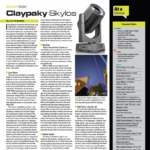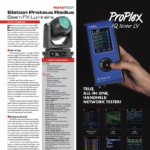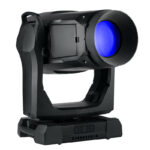Clay Paky is one of the most respected and well-established moving light companies on the planet, and they have a solid line of products going back well into the 1980s. The company seems to have a knack for releasing products that become hits — like the Sharpy, the Mythos and the B-Eye. Today we’re going to look not at the latest LED offering, but at a good old-fashioned large-format arc lamp fixture: the Scenius.
The Scenius is unabashedly an arc-lamp fixture with a 1,400-watt lamp from Osram with a Lok-It base. To change the lamp, users loosen four captive screws at the rear of the head, remove the cover and twist out the old lamp before inserting a new one. All parts remain captive during installation so there should be no problem with changing a lamp while hanging. I measured output of the light at 50 percent zoom from five meters and read 12,000 lux at the center of the beam. There is a moderately pronounced hotspot with this optical system, but this is still a respectable output. The lamp can also be run at a lower 1200-watt mode.
![The fixture’s actual dimming curve [in green], vs. ideal square [blue], linear [red] and S [yellow] curves.](https://plsn.com/wp/wp-content/uploads/16/03/current/3-Dimmer_curves800.jpg)
Dimming and Movement
Immediately in line after the lamp, reflector and hot mirror are a pair of dimmer flags. These are of a design I’ve seen before in Clay Paky lights, a pair of metal flags with a comb-like edge on top of which sits frosted glass to help smooth out the edges out. The flags work quite well; the dimming very closely follows an ideal square law curve, and it was extremely smooth and even across the field.
Pan and tilt ranges are 540º and 268º respectively. A full-range pan rotation took 4.9 seconds and full-range tilt took 3.2 seconds, though there is a “fast” setting in the menu system that speeds both of these up a bit. Pan and tilt locks are provided for transport, which I found somewhat fiddly, requiring a fair amount of pressure to lock and unlock.

Color and Gobos
The next module in line is the color module. The color mixing system consists of four pairs of glass flags that open and close like curtains by running back and forth on a pair of tracks. These have a slight patterning on them toward the leading edges, though far less than I expected. Despite this, the system performs excellently — the colors are rich and saturated, and I was able to mix very difficult colors like peach, lavender, and aqua without issue. The colors chosen for the system are good; in particular I found the yellow to be balanced to my taste, not too “chrome-y” or amber.
Like all hard-edged fixtures with variable focus, there are some positions that are better than others if you want an evenly colored beam. For instance, there are some slightly unevenly colored edges present when you focus on the gobo wheels, but this is a characteristic common to all optical systems of this sort. In comparison to other lights of this class the evenness is quite good, and I suspect that the module’s position in the optical train is partly responsible for this. In short, this is a very usable color mix system.
Gobos and fixed colors are on a separate module. The fixed color wheel consists of seven trapezoidal dichroic filters on a wheel plus open. These are glued in place and are, therefore, not user-replaceable. The gaps between adjacent filters are very small, allowing for very usable split colors. The included colors are chosen to complement the mix system, including (among others) a deep amber, saturated red, and a Congo blue. This wheel is snappy, and there is an optional shortest-path algorithm the user can choose if desired. A variable CTO filter is included.
Gobos are also on this module; two wheels of six gobos each plus open. All are rotating. The fixture does not come with fixed gobos as a standard option, but the user can replace the animation wheel with a fixed gobo wheel if desired. There’s a good mix of both breakups and aerial patterns here. In my opinion, most of the designs chosen will be more useful for aerial projection than pattern projection, but this isn’t a negative, it’s simply a value judgment that Clay Paky made for the likely users of this light. All gobos use the familiar slot and lock system and are user-replaceable. Rotation is very smooth down to the slowest speeds. Gobo focus exhibited minor amounts of chromatic aberration, but nothing objectionable.
Also on this module is the animation wheel, a large patterned wheel that moves via a linear actuator into and out of the beam. Insertion was reasonably fast, and the wheel provides good animation effects for water or fire. The strobe flags are also on this module, and the unit has the expected strobe functions — a constant-rate strobe from 1 to 12Hz, as well as pulses and random strobe effects. The 16-blade iris is also here, which smoothly reduces the beam aperture and also has macros for easy programming.
Next in line is the optical system, including the moving lens elements, the two frost filters and the four-facet prism. The frost filters are interesting — they are controlled by one channel, so when the frost channel reaches a DMX value of 128, the second filter moves in over the first. The first is a subtle filter that diffuses the edges of gobos but still allows the pattern to come through, while the second is a heavy frost filter that essentially turns the output into a wash. The prism inserts reasonably quickly and provides good image separation, though it can accentuate unevenly colored beams with half-mixed colors.
Zoom is very fast and covers a wide range, from 8º to 50º. Focus tracking works reasonably well, however, it is important to note that the zoom travel range is greater than the focus travel range. Therefore, at the narrowest zoom ranges, you cannot get gobos into focus. Clay Paky clearly prioritized a greater zoom range over making sure both ranges overlapped perfectly, and it’s just something to be aware of in your programming.
Serviceability
The modular nature of this light should make servicing very easy. All screws on the body remain captive when removed, and Clay Paky has gone the extra mile in designing a safety attachment system for the exterior covers that isn’t a pain to use. Instead of a tiny fiddly carabiner or a screw that has to be loosened, the safety cable ends in a small cylinder-shaped “key” that easily locks and unlocks in a small receptacle. This is something that I dislike on many lights — the safeties for the head covers are on very short cables and get in the way. The system here, by contrast, is extremely convenient.
The modules themselves are easy to remove as well, with the screws remaining captive and guides to hold everything in the correct place. These little details show the commitment to quality that Clay Paky is known for, and demonstrate that they think about the entire personnel chain.
The fixture weighs 83.6 pounds (38kg) and is about 30 by 19 inches (HxW, at the outside of the yokes). It accepts power via Neutrik PowerCON True1, and auto-ranges from 200 to 240V. Rigging hardware is industry standard quarter-turn Omega-style brackets. The fixture accepts DMX via a 5-pin connector, or Art-Net through an onboard Ethernet port.
At a Glance:
Another Promising Fixture for Large-Scale Rigs
The Scenius is another in a long line of high-quality offerings from Clay Paky, and showcases a real commitment to quality, both in terms of features and construction. The dimming curve, smooth color mixing, and feature set, including gobos, effects and optics, work together in a light that should be at home in any large-scale rig.
Clay Paky Scenius
- PROS: High output, smooth color mixing, even dimming
- CONS: Cannot swap filters on the color wheel.
SPECS
- 1400W Osram Discharge Lamp
- 1400W/1200W Operating Modes
- Focus Tracking System
- 6500K Output Color Temperature
- Very High CRI
- CMY System + Linear CTO
- 7-Color Wheel
- 2 Wheels w/ 6+6 Rotating Gobos
- Rotating Prism
- Interchangeable Graphics Wheel
- 16 Blade Iris
- Variable “Soft Edge” Frost
- Variable Flood Frost
- 0-100% Dimmer
- Fast Stop/Strobe Effect
- Art-Net/RDM Operation
Zoom: 8°-50°
Pan/Tilt: 540°/268°
Size: About 30” x 19”
Weight: 83.6 pounds
MSRP: $15,310
More Info: www.claypaky.it



